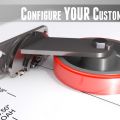Are cast iron casters worth it?
With so many ground breaking innovations in metal materials for caster construction you may be wondering why cast iron casters are still on the market. They were one of the original caster forms, and they remain in use today. While not as prevalent, they are recognized as having a highly specialized role in the industry; one that no other metal caster can perform.
The real attraction to cast iron casters
There are three reasons why cast iron casters remain popular. The first is that they can support heavy weights. The second is that pig iron is easy to cast into any form you can think of, keeping production and manufacturing costs low. The third is the big one, cast iron casters are some of the cheapest casters you can by. That comes with a tradeoff though – for all its strength and malleability these casters can shatter easily and don't have great tensile strength. That could be a bonus for you, as can the malleability of the pig iron used to create the caster.
What that malleability means for you
Malleability means you can pour almost any type of mold with cast iron. This allows for greater customization without a high cost of mold preparation. If you need a long or short run of a custom caster style, doing it in cast iron can be your most cost effective choice.
Mitigating loss
One of the most important factors in favor of selecting cast iron casters, as mentioned before, is their cost. Cheap has its place, especially when it is a part of your program to mitigate loss. If your facility is using trolley or cart transport for heavy loads, and is a high risk loss area – such as in a foundry or mining area, or any other area where collapse is a high possibility – making sure you can afford to lose your casters is an issue. Another issue with loss is the fact that these casters do not have high tensile strength and can shatter under shock. Why would you want a caster like that? You want it if the anticipated shock is going to cause a situation where you want the load immediately immobilized. This can be the best form of brake to have in certain circumstances.
Options you can get with them
Almost all of the standard options for other caster types are available with cast iron casters. There is less of a precision machining capability with some aspects of the design, but the casters can take most of the brake and safety options available on other styles. They can also use most of the wheel types too. Although, as mention in the section on mitigating loss, if making sure the caster itself is expendable you also want to make sure that you are choosing a wheel type that is the same.
Talk to an expert before you decide
Before you decide that cast iron casters are your solution – or not, talk to an expert at Caster Concepts who knows what each caster type can really do. They can help you decide whether using standard casters, or casting custom ones, will be the best way to meet the needs of your business. With cast iron casters there is more flexibility than you may expect with the specifications they can reach. As long as their limits and capabilities match your transport needs, it could be the right match for you.
For More Info About Cast iron casters Visit Us.
Source: Click Here



